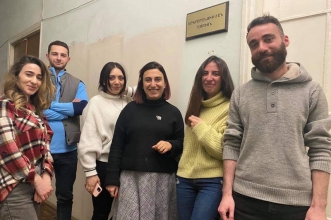Interview with Lilit Sargsyan, Head of the Chair of Geology of ISEC NAS RA
March 1, 2021
- What is the mission of the Chair of Geology of the International Scientific-Educational Center of NAS RA?
- The Chair of Geology, opened in 2013 on the basis of the professional potential of the Institute of Geological Sciences of the National Academy of Sciences of the Republic of Armenia, aims to attract young people to the field of active geological research, to activate their participation in modern research. The chair provides a wide range of opportunities for the researcher, both theoretical (processes taking place in the Earth's crust, topics related to the Earth's structure and Earth's history), as well as practical knowledge (geological hazards assessment, environmental issues, hydrogeochemistry, mineral exploration) methods) for acquisition.
- Dear Mrs. Sargsyan, from your perspective, which professionals prefer to continue their studies in the master's program of "Geology" and get the qualification of a geologist?
- According to the tradition, applicants with a bachelor's degree in geology mainly have the desire to continue their studies in the same master's program, but in recent years it seems that the tradition is changing people with bachelor's degrees in applied mathematics, geography, ecology, physics, chemistry, biology and even linguistics apply. This is very welcome, because geology is one of the branches of natural sciences, the study of which is closely connected with other branches of natural sciences. After all, geology as a science is related to a wide range of scientific directions, its field of research also includes a number of related sciences. Some branches of geology, such as geophysics, geochemistry, geoinformatics are of interdisciplinary nature.
- What is the format of courses organized in the chair? Do you have the opportunity to organize practical courses? What other opportunities do the Department of Geology and the Institute of Geological Sciences provide students?
-During their studies, master students learn about geological knowledge of active tectonics, geological hazards, seismology, volcanology, sedimentology, geochemistry, geophysics, hydrogerachemistry, minerals, their search methods, petrology, petrography, world orthography. In addition to imparting theoretical knowledge, the chair provides students with the opportunity to participate in the sphere wok and laboratory work of the institute. During the study, they are given the opportunity to analyze various research results in their laboratories. Students can use modern technology for research, as well as improve their computational skills. One of the goals of the Chair of Geology at the Institute of Geological Sciences is to involve students in the research programs of the Institute, as work experience is the best way to acquire knowledge.
- What international programs and partnerships are available to students via the chair?
- The Institute of Geological Sciences conducts joint scientific research with experts from France, Switzerland, Germany, Great Britain, the United States, Iran, Italy, Taiwan and other countries.
The Institute of Geological Sciences founded an Armenian-French international laboratory in 2012, in collaboration with the French National Center for Scientific Research (CNRF), during which new, significant information in the fields of seismotectonics and archeology was obtained. Universities in France, Switzerland, Germany, and the United States continue to educate young professionals.
For example, as part of the "Erasmus credit mobility" program, freshmen from the Department of Geology have the opportunity to continue their studies at the University of Lille this year. The university has a variety of options for radiolar laboratory examinations. This study would be extremely beneficial to them while they work on their master's thesis.
As a result of the long-term collaboration between the Institute of Geological Sciences of the National Academy of Sciences of the Republic of Armenia and the University of Lille, there will be opportunities for graduate exchange programs in addition to phd programs.
- How easy is it for a graduate of "Geology" profession to find a job in Armenia? How much do you support them in this direction?
- At the moment, three of our students work in different laboratories of the institute.
The best students are often given the opportunity to work at the Institute of Geological Sciences, with the possibility of continuing their education after graduation. By specializing in a variety of geological surveys, our graduates may also be involved in environmental, geological hazard assessment, remediation, and identification of ways and means to minimize those hazards.
- What challenges and development opportunities do geologists face today?
- Working in the field of science in Armenia is not particularly appealing to young people, owing to low salaries and a lack of well-developed research infrastructure. Another major issue is the exodus of qualified scientists from the field. These are serious barriers.
In several fields of geology, however, there is a high demand for young and knowledgeable personnel. There are many other ways where positive outcomes can be obtained, including through international cooperation.
